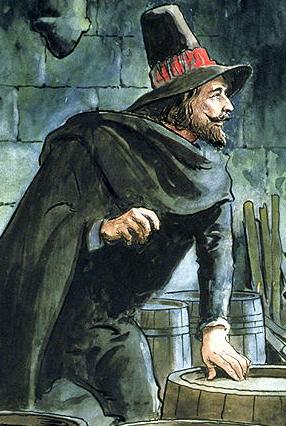 Guy Fawkes, from ‘Peeps into the Past’
Guy Fawkes, from ‘Peeps into the Past’
Born in York to Edward and Edith Fawkes, Guy Fawkes was baptised a Protestant at St Michael le Belfry on the 16th April 1570. His father was a proctor of the ecclesiastical courts and advocate of the consistory court of the Archbishop of York, who died when the boy was eight. Guy’s mother later married a Catholic, Dionis Baynbrigge and Guy Fawkes converted to Roman Catholic.
Guy Fawkes went to Europe to fight for the Spanish Catholics in the Eighty Years War. While fighting in Flanders, he was asked by Thomas Wintour to join a plot by Robert Catesby to kill the Protestant King James and as many Members of Parliament as possible.
In 1604 Fawkes met Robert Catesby, along with Thomas Wintour, Thomas Percy and John Wright and at the Duck and Drake Inn to plan the conspiracy. Over time they were joined by Francis Tresham, Everard Digby, Robert Wintour, Thomas Bates and Christopher Wright.
Catesby planned to blow up the King as he opened the Houses of Parliament on 5th November 1605, then to have Princess Elizabeth kidnapped from Coombe Abbey. She was to be married to a Catholic nobleman and installed as a Catholic monarch. The conspirators continued with this plan even though Prince Henry, the heir to the throne, would not be at the opening of Parliament and, therefore would not be blown up and could rightfully claim the throne himself.
Renting a house next to the Houses of Parliament, the Gun Powder Plot conspirators initially tried to tunnel under Parliament. Later, they were able to hire a cellar under the House of Lords in the name of Thomas Percy, which they filled with barrels of gunpowder. Having gained munitions experience during the war in the Netherlands, Guy Fawkes was charged with creating the explosion.
However, Francis Tresham became concerned the explosion would kill his brother-in-law, Lord Monteagle, so he sent him a letter warning him not to attend Parliament on 5th November. Being suspicious, Lord Monteagle passed the letter to Robert Cecil, who ordered a search of the Houses of Parliament.
On 4th November Lord Monteagle and the Earl of Suffolk searched the Lords Chamber and the vaults below. They found a man calling himself John Johnson in the cellars. He claimed to be storing wood for Thomas Percy. At first they accepted his story, but later Lord Monteagle suggested to the Earl of Suffolk that he knew Thomas Percy and didn’t know why he would need to store wood in the vaults.
Having raised more suspicions, the King insisted the vaults be searched again. That night armed guards searched the vaults and discovered the thirty-six barrels of gunpowder and fire-lighting equipment as well as the wood. Guy Fawkes was arrested at midnight on 4 November 1605 beneath the House of Lords.
As the other Gun Powder Plot conspirators were rounded up, Guy Fawkes was sent for torture. Technically torture was illegal, and James I had to personally give a licence for its use. At first, he refused to speak under torture, but finally Guy Fawkes signed a confession.
He was found guilty of treason and sentenced to the traditional traitors’ death – to be ‘hanged, drawn and quartered’. However, when he was executed on 31st January, 1606 he jumped from the gallows, breaking his own neck. In so doing he avoided being cut down while still alive and seeing his testicles cut off and his stomach split open. His body was still hacked into quarters and his remains sent to “the four corners of the kingdom” as a warning to others.
In celebration of thwarting the plot to blow up parliament bonfires were lit across London. This custom spread across the country and 5th November became a day of annual thanksgiving. Commemorative fireworks have been let off since the mid-seventeenth century to mark the occasion. The Guy Fawkes legend continued to grow, and by the 19th Century his effigy was being placed on the bonfires. Although the religious aspects have been blurred over time, and it is no longer seen as a day of thanksgiving, “Bonfire Night” is still a national celebration in the United Kingdom.
Reblogged this on Explore, Discover, Experience.